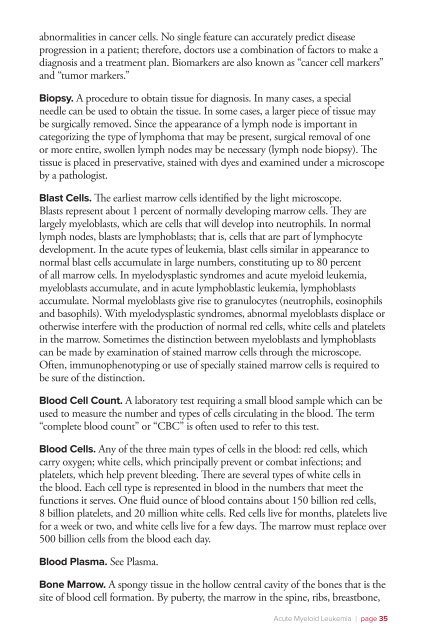Acute Myeloid Leukemia - The Leukemia & Lymphoma Society
Acute Myeloid Leukemia - The Leukemia & Lymphoma Society
Acute Myeloid Leukemia - The Leukemia & Lymphoma Society
- No tags were found...
You also want an ePaper? Increase the reach of your titles
YUMPU automatically turns print PDFs into web optimized ePapers that Google loves.
abnormalities in cancer cells. No single feature can accurately predict diseaseprogression in a patient; therefore, doctors use a combination of factors to make adiagnosis and a treatment plan. Biomarkers are also known as “cancer cell markers”and “tumor markers.”Biopsy. A procedure to obtain tissue for diagnosis. In many cases, a specialneedle can be used to obtain the tissue. In some cases, a larger piece of tissue maybe surgically removed. Since the appearance of a lymph node is important incategorizing the type of lymphoma that may be present, surgical removal of oneor more entire, swollen lymph nodes may be necessary (lymph node biopsy). <strong>The</strong>tissue is placed in preservative, stained with dyes and examined under a microscopeby a pathologist.Blast Cells. <strong>The</strong> earliest marrow cells identified by the light microscope.Blasts represent about 1 percent of normally developing marrow cells. <strong>The</strong>y arelargely myeloblasts, which are cells that will develop into neutrophils. In normallymph nodes, blasts are lymphoblasts; that is, cells that are part of lymphocytedevelopment. In the acute types of leukemia, blast cells similar in appearance tonormal blast cells accumulate in large numbers, constituting up to 80 percentof all marrow cells. In myelodysplastic syndromes and acute myeloid leukemia,myeloblasts accumulate, and in acute lymphoblastic leukemia, lymphoblastsaccumulate. Normal myeloblasts give rise to granulocytes (neutrophils, eosinophilsand basophils). With myelodysplastic syndromes, abnormal myeloblasts displace orotherwise interfere with the production of normal red cells, white cells and plateletsin the marrow. Sometimes the distinction between myeloblasts and lymphoblastscan be made by examination of stained marrow cells through the microscope.Often, immunophenotyping or use of specially stained marrow cells is required tobe sure of the distinction.Blood Cell Count. A laboratory test requiring a small blood sample which can beused to measure the number and types of cells circulating in the blood. <strong>The</strong> term“complete blood count” or “CBC” is often used to refer to this test.Blood Cells. Any of the three main types of cells in the blood: red cells, whichcarry oxygen; white cells, which principally prevent or combat infections; andplatelets, which help prevent bleeding. <strong>The</strong>re are several types of white cells inthe blood. Each cell type is represented in blood in the numbers that meet thefunctions it serves. One fluid ounce of blood contains about 150 billion red cells,8 billion platelets, and 20 million white cells. Red cells live for months, platelets livefor a week or two, and white cells live for a few days. <strong>The</strong> marrow must replace over500 billion cells from the blood each day.Blood Plasma. See Plasma.Bone Marrow. A spongy tissue in the hollow central cavity of the bones that is thesite of blood cell formation. By puberty, the marrow in the spine, ribs, breastbone,<strong>Acute</strong> <strong>Myeloid</strong> <strong>Leukemia</strong> I page 35
















